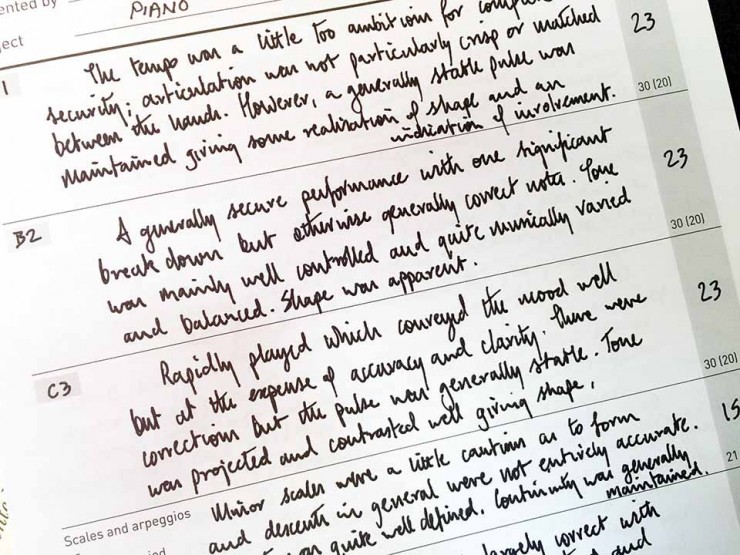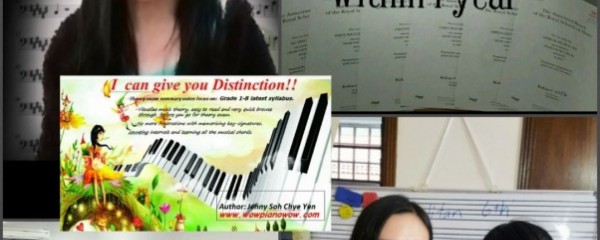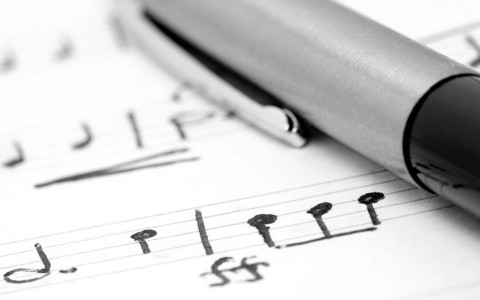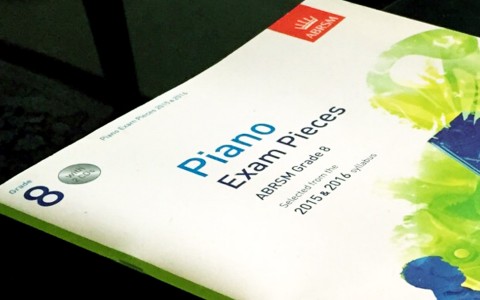Ever wonder how the ABRSM Graded Practical Piano Exams are being marked? Why is it that you feel you had played the prepared piece very well, but did not score a distinction? Will having a few slips during playing the scales and apreggios affect the marks a lot? If you cannot answer some aural test questions confidently, does this compromise the exam results significantly? How should you perform during the sight reading test to score high? Indeed, these are very common questions every candidate face, and probably uncommonly answered. Today, we take you to the secret chamber where the marking rubric is revealed!
A scoring rubric, as described in Wikipedia, is an attempt to communicate expectations of quality around a task. In many cases, scoring rubrics are used to delineate consistent criteria for grading. Because the criteria are public, a scoring rubric allows teachers and students alike to evaluate criteria, which can be complex and subjective. A scoring rubric can also provide a basis for self-evaluation, reflection, and peer review. It is aimed at accurate and fair assessment, fostering understanding, and indicating a way to proceed with subsequent learning/teaching. This integration of performance and feedback is called ongoing assessment or formative assessment.
The ABRSM Graded Music Exam Rubric shows tables of all assessible components in the syllabus with their marking criteria. The ABRSM piano exam syllabus comprises 4 components: (i) prepared 3 pieces, (ii) scales and arpeggios, (iii) sight reading, and (iv) aural tests.
|
Mark
|
Pitch
|
Time
|
Tone
|
Shape
|
Performance
|
|
Distinction
27–30
|
- Highly accurate notes and intonation
|
- Fluent, with flexibility where appropriate
- Rhythmic character well conveyed
|
- Well projected
- Sensitive use of tonal qualities
|
- Expressive, idiomatic musical shaping and detail
|
- Assured
- Fully committed
- Vivid communication of character and style
|
|
Merit
24–26
|
- Largely accurate notes and intonation
|
- Sustained, effective tempo
- Good sense of rhythm
|
- Mainly controlled and consistent
- Good tonal awareness
|
- Clear musical shaping, well-realised detail
|
- Positive
- Carrying musical conviction
- Character and style communicated
|
|
Pass
20-23
|
- Generally correct notes
- Sufficiently reliable intonation to maintain tonality
|
- Suitable tempo
- Generally stable pulse
- Overall rhythmic accuracy
|
- Generally reliable
- Adequate tonal awareness
|
- Some realisation of musical shape and/or detail
|
- Generally secure, prompt recovery from slips
- Some musical involvement
|
|
Below Pass
17-19
|
- Frequent note errors
- Insufficiently reliable intonation to maintain tonality
|
- Unsuitable and/or uncontrolled tempo
- Irregular pulse
- Inaccurate rhythm
|
- Uneven and/or unreliable
- Inadequate tonal awareness
|
- Musical shape and detail insufficiently conveyed
|
- Insecure, inadequate recovery from slips
- Insufficient musical involvement
|
|
13-16
|
- Largely inaccurate notes and/or intonation
|
- Erratic tempo and/or pulse
|
- Serious lack of tonal control
|
- Musical shape and detail largely unrealised
|
- Lacking continuity
- No musical involvement
|
|
10-12
|
- Highly inaccurate notes and/or intonation
|
- Incoherent tempo and/or pulse
|
|
|
- Unable to continue for more than a short section
|
|
0
|
|
|
|
|
|
|
Mark
|
Criteria
|
|
Distinction
19–21
|
- Highly accurate notes/pitch
- Fluent and rhythmic
- Musically shaped
- Confident response
|
|
Merit
17–18
|
- Largely accurate notes/pitch
- Mostly regular flow
- Mainly even tone
- Secure response
|
|
Pass
14-16
|
- Generally correct notes/pitch, despite errors
- Continuity generally maintained
- Generally reliable tone
- Cautious response
|
|
Below Pass
11-13
|
- Frequent errors in notes and/or pitch
- Lacking continuity and/or some items incomplete
- Unreliable tone
- Uncertain response and/or some items not attempted
|
|
7-10
|
- Very approximate notes and/or pitch
- Sporadic and/or frequently incomplete
- Serious lack of tonal control
- Very uncertain response and/or several items not attempted
|
|
0
|
|
|
Mark
|
Criteria
|
|
Distinction
19–21
|
- Fluent, rhythmically accurate
- Accurate notes/pitch/key
- Musical detail realised
- Confident presentation
|
|
Merit
17–18
|
- Adequate tempo, usually steady pulse
- Mainly correct rhythm
- Largely correct notes/pitch/key
- Largely secure presentation
|
|
Pass
14-16
|
- Continuity generally maintained
- Note values mostly realised
- Pitch outlines in place, despite errors
- Cautious presentation
|
|
Below Pass
11-13
|
- Lacking overall continuity
- Incorrect note values
- Very approximate notes/pitch/key
- Insecure presentation
|
|
7-10
|
- No continuity or incomplete
- Note values unrealised
- Pitch outlines absent
- Very uncertain presentation
|
|
0
|
|
|
Mark
|
Criteria
|
|
Distinction
17–18
|
- Accurate throughout
- Musically perceptive
- Confident response
|
|
Merit
15–16
|
- Strengths significantly outweigh weaknesses
- Musically aware
- Secure response
|
|
Pass
12-14
|
- Strengths just outweigh weaknesses
- Cautious response
|
|
Below Pass
9-11
|
- Weaknesses outweigh strengths
- Uncertain response
|
|
6-8
|
- Inaccuracy throughout
- Vague response
|
|
0
|
|
Certainly, what the examiner is looking for, are now no longer puzzles. The rubric has clearly listed down how a candidate is placed in the 'distinction', 'merit' and 'pass' band.
The candidate can advantageously use this rubric to help in his personal progress, or for fine-tuning his exam preparations. Additionally, the score sheet, which is returned to the candidate after the examination, presents the examiner's comments on each assessible component. This enables the candidate to gain a better insight where he can improve on, and the piano teacher to chart his piano lessons effectively to help his students in their weak areas.



























